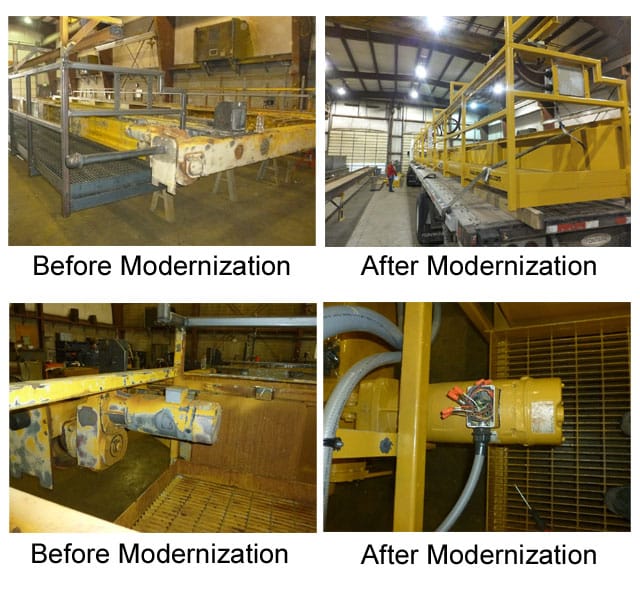To keep your employees and goods safe and your business running smoothly, you need reliable equipment. You need balanced forklifts, steady and sure machine operators, and a sturdy crane. Unfortunately, industry experts estimate that more than 50% of cranes in use operate beyond capacity. Maybe you’ve notice wobbling, poor operating control, a decrease in load bearing capacity, or signs of excessive wear. Maybe it just came to your attention that your crane’s more than 30 years old. Either way, you need to make an upgrade to ensure you meet safety and efficiency standards. You likely have two main choices: modernization or replacement. In this blog, we give you an overview of each to help you make a decision.
When to Modernize
Modernization bridges the gap between total replacement and minor repairs. These improvements improve the way the crane operates without the cost and inconvenience of replacement.
Modernizations: “Modernization” generally refers to any modification that enhances equipment performance. These upgrades may include:
- Capacity expansion
- Hoist replacement or improvement
- Power source change, usually from DC to AC
- Radio control system installation
- Variable speed drive installation
Some modernization companies complete upgrades on-site. However, your modernization company may need to dissemble the crane and work on it off-site if it requires major modifications.
Signs You Should Modernize Your Crane:
Modernizations extend the life of structurally sound cranes. They cannot restore severely damaged, structurally compromised, or exceptionally old cranes. Consider modernization if your crane falls under any of the following criteria:
- Individual System Failure: Over time, individual systems may become inefficient or obsolete. If you notice problems with operation, schedule an inspection. You may need to modernize the drive control system, hoist, or other integrated system.
- Over 30 Years Old: Until recently, older technology limited crane capacity. Cranes made within the last 25 years or so can lift larger loads with higher frequency. If your crane’s manufacturing date goes back farther than 30 years, its limited capacity likely affects business efficiency. Consider capacity expansion modernizations.
- Worn Safety Measures: Even if your crane once met safety and comfort standards, consistent use may have worn down walkways and guardrails. You don’t need a failed inspection or a worker’s compensation suit on your hands if one of these worn down safety measures fall through. Invest in bridge bumpers that meet OSHA requirements, refurbished walkways and handrails, and new safety controls.
When to Replace
While you may feel tempted to keep making repairs indefinitely over replacing your crane, doing so compromises safety and operating performance. This Band-Aid approach eventually leads to a hodge-podge piece of equipment that no longer fulfills its intended purpose. Set aside funds for a new, more current crane model if your notice any of the following signs:
- Decreased Productivity: Look at your operating performance records. Has your crane’s load bearing capacity, speed, or ease of operation decreased significantly since its purchase? In the short-term this decrease may not mean much. But without replacement, this outdated crane may affect your entire business model by slowing the process significantly.
- Multiple Recent Repairs: One round of modernizations or refurbishment doesn’t spell your crane’s demise. However, if it seems like one system after another breaks down, even after you perform repairs, consider partial or full replacement. Parts Have Expired Warranties: Heavy equipment doesn’t last indefinitely. Most of your crane’s systems and components have manufacturer or supplier warranties. Even parts that don’t have warranties may have professional recommendations on replacement frequencies. Don’t wait for a problem-replace expired parts immediately, either as part of a larger replacement or a modernization effort.
- Several Safety Issues: Pay attention to the number of injuries, equipment issues, and malfunctions surrounding your crane. If any stand unexplained, consider replacement. If you haven’t had an injury yet, that doesn’t mean your crane meets safety requirements. Dispel any doubt and keep your operators safe by having a professional evaluate your crane.
How to Proceed
Not sure if your crane’s performance requires revamping or replacement? Consult with the crane’s manufacturer or supplier. If you have an older crane, you’ll likely find that other operators experienced problems similar to yours. Use their experiences to inform your decisions going forward.
Before undertaking either modernization or replacement, schedule a crane reliability study or an inspection. This report will help you determine the extent of any aging or damage. Professional equipment inspectors can also provide recommendations on how you should proceed. Even if your crane seems good to go with just a tune-up or minor repair, ensure it stays reliable and efficient by scheduling regular assessments.
Train your operators on correct use to decrease the chance of crane strain. Comply with all OSHA and safety standards. Meet with an inspector annually to evaluate your equipment’s future.
At American Equipment Inc., we provide cost-effective crane inspection and modernization services.
Find your local American Equipment, Inc. office to get started!
Trackback from your site.


